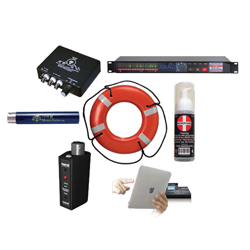Other than the desk, today’s in-ear monitor rig often isn’t much more than a rack of transmitters and a subwoofer or shaker. But a few choice accessories can be helpful to successful in-ear monitor mixing.
A digital word clock for re-clocking the digital console isn’t necessary but can provide improvements in audio quality that can be noticeable in IEM mixes. While an Apogee Big Ben can ride in the power supply rack, Black Lion’s 3-by-4-inch, 3-port Micro Clock is small enough to fit in your gig saver kit. Short 75-ohm cables work better than long ones, so a 5- or 10-foot BNC is a perfect companion for an outboard digital word clock.
An intercom adaptor that blocks DC voltage, such as the Masque Sound “Clear-Com Recording” XLR barrel adaptor, can take a channel of intercom and convert it to line level audio that can be added to the engineer’s cue mix or even fed to the mixes of the other technicians.
A momentary push-to-talk CB-style microphone wired to pins 1 and 2 of an A4F connector becomes the partner for this scheme of tying intercom audio into the monitor desk, as you still need a way to respond to the intercom.
A switched handheld mic for talking to the band becomes important since the best way to communicate is by talking into their mix. Most manufacturers offer low-cost switched dynamic handhelds. Get one for your crewmate on the other side of the stage and pan them hard in all of the stereo mixes.
A “proximity gate” like the Sabine infra-red Phantom Mic Rider, which mounts at the back of a vocal mic, is helpful for communications from the musicians. It allows one or more vocal mics on stage to be dedicated to communicating with the monitor engineer or the rest of the band, but it remains muted when no one stands in front of the mic.
The lead singer might have his/her own talkback mic, while the band shares a second and maybe the drummer a third. Pretty soon a Mackie 1202 compact mixer comes in handy to mix the extra communication inputs (including front of house) to the monitor system into a single (stereo) input.
Multi-track recording allows virtual sound check using the previous night’s tracks. A Dante Virtual SoundCard or RME MADIface makes it easy to connect a laptop to multi-track the show. A JoeCo BlackBox recorder can simplify multi-track recording without risking a laptop at the venue by recording directly to a hard-drive.
Cleaning mics, earpieces and bodypacks becomes even more important in cold and flu season. Sick singers get shows canceled. Tommy McCoy’s Microphome is a fast-drying foam disinfectant that cleans and sanitizes, and it’s used on top tours and even on the Grammys.
Whether you use a manufacturer’s proprietary iPad app or a VNC client to remotely control the console via an attached laptop, the experience for the musicians is far more collaboratory when you can walk up to your artist. Traversing the stage with iPad in hand dictates that the engineer’s switched handheld console mic needs to become a wireless headset. A proliferation of decent-sounding miniature condenser headset or earset mics can work in this situation, since it’s just for communication. So is the wireless, and it doesn’t need to be top shelf either. By the way, your IEM cue pack also needs to be wireless at this point.
See you in catering!
Mark Frink is a long-time mix engineer who also previously served as editorial director for Live Sound International.















